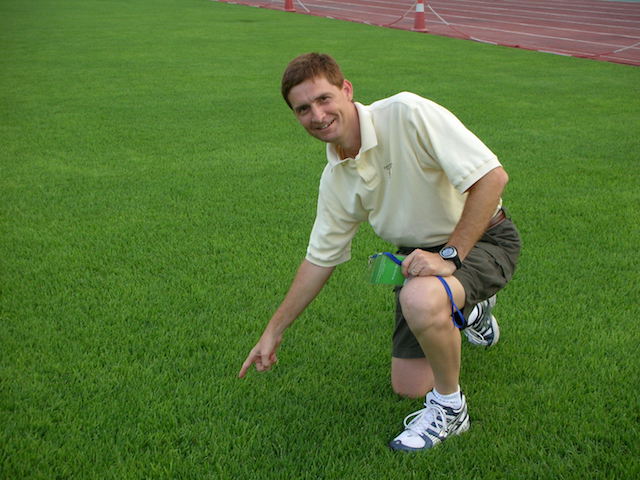This Dr. Grady Miller “Q&A” column appears in the January issue of SportsTurf.
Q: I noticed football players slipping on our ryegrass fields (overseeded bermudagrass) this fall. Is there anything we could have done differently with the ryegrass to reduce the slipping?
A: This is a great question and a great time of the year to talk about this subject. Also, I feel like I am honoring my good friend, the late Bob Campbell, when I get a chance to talk about slick ryegrass. We lost an icon in our industry in November 2017. He was a tireless spokesperson for STMA and sports turf managers across the country in addition to being a good friend to many of us in this industry. Bobby provided a number of questions for this column over the past 16 years and was a great resource for me as I formulated some of my answers. Overseeding bermudagrass with ryegrass was always one of his favorite talking points.
I do not think there is any need to argue that damp ryegrass is “slicker” than bermudagrass. It has a very glossy, glabrous leaf surface. The shiny leaves are largely due to a waxy leaf cuticle. In everyday life, waxes have been used as lubricants, polishes, and for waterproofing. It can provide similar traits to the plant by increasing slickness of the leaves and keep more moisture on the leaf surface for the greater slipperiness when there is moisture. But the trait is not all bad. In addition to agronomic benefits to the plant, the trait provides as least one great sports turf benefit: the glossy leaf surface reflects light in a dramatic way, allowing the distinct striping patterns that have become so popular in our industry.
In contrast bermudagrass leaves tend to be dull, so the grass does not stripe well. While bermudagrass leaves are prone to have dew formation, the lack of a waxy layer on the leaf surfaces means it does not have the same level of slipperiness compared to ryegrass. The strong lateral growth habit of bermudagrass also helps with traction issues since it is more prone to holding a football cleat than the more upright growing ryegrass.
The ryegrass leaf morphology may be only part of the problem. Bob used to say the bigger cause of the slipperiness was the “snot layer” that would form at the soil surface from decaying plant tissue. The wet, slimy layer from the partially green and partially decayed leaves and stems looks like slimy, greenish-black thatch. He felt that cleats would slide over and in that slimy layer, never really digging into the underlying soil.
So, the question becomes how much does this all matter? While ryegrass is slicker, it seems to me coaches have probably overemphasized this point. I know early in my university career we had a “head ball coach” that hated ryegrass and whenever the team played poorly, it was sometimes thrown in as a contributing factor. I sometimes wondered what the coach would have said if a reporter reminded him that both teams were playing on the same field. That would have probably resulted in a few notable quotes. I should add that I do not think a field is unsafe just because it has a ryegrass surface!
There is still the question of what can be done to reduce the slickness. After Bob discovered this slick layer on the surface, he started trying a few ideas to minimize the problem. He found the best two ways to minimize the impact of this slick layer was to catch his clippings (trying to prevent it from getting started) and to lightly topdress before games. Bob’s topdressing approach was to put down just enough sand to provide some grit for the cleats when they came in contact with this slick layer. He was convinced it helped. I do not know if anyone ever tested that in-season practice, but studies have shown that summer topdressing of fields with permanent ryegrass or permanent bermudagrass has improved shoot density and shear strength come fall.
The other factor to consider is moisture. As mentioned before, leaf wetness will usually increase the slickness. So, games played after a recent rain or irrigation or during periods of heavy dew are prone to be slicker than those played on a dry field. Of course playing times cannot always be selected or rainfall be prevented. If an option, players may want to experiment with different cleat designs when playing on damp fields.
Of course sliding on fields is not all bad. A slide tackle is often used by defensive players in soccer to take the ball away from an opponent and baseball outfielders often use slides in catching balls that are nearly out of reach. In those cases, a cleat that slides may reduce the potential for injury. Football receivers and running backs still do not like much slippage when they plant a foot and change direction. Regardless of the sport, it will largely be up to the athlete to develop their balance considering the field conditions encountered. As Bob once told me, “I do not think the good (football) players slip—at least not as much.”
Dr. Grady Miller is a professor at North Carolina State University.


